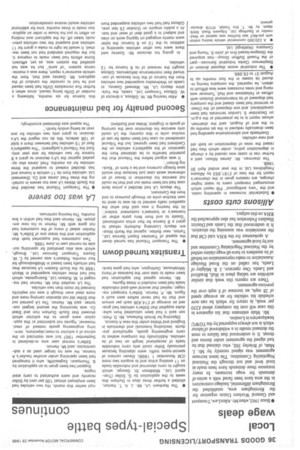Special-types battle continues
Page 38

If you've noticed an error in this article please click here to report it so we can fix it.
• The Northern LA, Mr. J. A. T. Hanlon, allotted a further three days in Durham this week to the application by G. Stiller (Transport) Ltd., Middleton St. George, which sought to carry abnormal and indivisible loads on 11 existing artios and to acquire two more (CM November 1 1968). Eleven carriers of special-types traffic were objecting because previously Stiller could only carry indivisible loads of exceptional length on two of its vehicles. Additionally the company wishes to carry engineering goods, agricultural products (excluding livestock) and chemicals in England and Wales under this new A licence.
Objecting for British Railways, Mr. D. Pattison said it had been calculated from schedules supplied that Stiller's vehicles had grossed an average of £14,436 each per annum and that he had never before seen such 'a figure. Mr. P. Herron, Stiller's transport manager, replied that several well-paid indivisible loads had been included in these figures.
Mr. Herron agreed that application had been made to take over the business of Harry Whitehouse, Darlington, who had gone bank rupt earlier this month. His two vehicles had been employed almost 100 per cent by Stiller recently and were authorized to carry steel ingots.
Support has been given to an application by B. Thompson, Eaglescliffe, who it transpired had been operating under another haulier's A licence. He was no longer used as a subcontractor, said Mr. Herron.
Stiller's normal user was re-declared in September 1967 but was restricted on the advice of a solicitor to meet objections, itemizing engineering goods instead of steel. However, figures not submitted at this application were given to the solicitor which showed that South Durham Iron and Steel Co. was becoming the second largest customer, said Mr. Herron. The LA pointed out that Stiller did not abandon carrying more and more steel even though it was not explicitly licensed for more than two vehicles.
The LA recalled that Mr. Herron had managed H. M. Robson Ltd., Basingstoke, which had had three vehicles suspended in March 1966 by the South Eastern LA because they had virtually been based in Middlesbrough for four months. Robson's was owned by C. W. Sayers Transport Services Ltd., Brough, which was also penalized for operating outside its normal user in June 1966.
Two customers had supported both that application and this latest one of Stiller's. Mr. Hanlon asked if many of the customers had not gone with Mr. Herron to his new employer. Mr. Herron said they had within a few months. The hearing continues.




















































































































